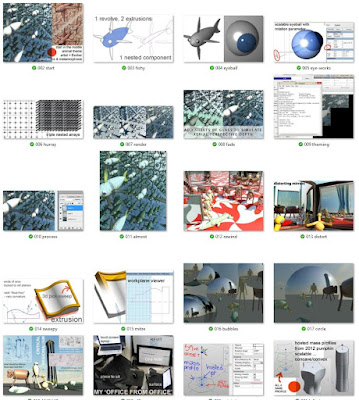This is the next episode in a series looking back at old blog posts.
Late 2013 and approaching my third Pumpkin competition. This is the one where I went way off topic, and to be honest bit of more than I could chew. All the same I learnt a lot and just as importantly realised the need for some course correction for my fourth and final pumpkin adventure the next year.
I had established a ritual of choosing a sculptural approach, a segment of the natural world, and a featured artist. The artist this time was to be Mauritz Escher. And as a warm-up exercise I attempted a reinterpretation of one of his topological motifs, which I called the “Y-knot”
It’s created in “Point World” using a cylindrical rig, which itself is scalable. Meanwhile the feeble pun of the title allowed me to explore my reasons for finding the annual pumpkin competition such a rewarding experience. It couldn’t last forever of course, but for those 4 years it really helped me to formulate my approach to BIM as an expressive tool for exploring human culture as expressed in buildings.
https://grevity.blogspot.com/2013/10/y-knot.html
Around that time, I had done some dabbling with an approach to fractals, borrowed from Tim Waldock (The Revit Cat). For a while, I had high hopes that this would generate some usable Tree families, but that never really materialised. Typically clever stuff from Tim though and definitely worth exploring the technique.
https://grevity.blogspot.com/2013/10/fractalisation.html
I did make some progress with trees eventually. First another dead-end, building on an idea from another of my BIM-buddies, Kelvin Tam. This did result in a semi-usable palm tree substitute, but more importantly it drew me into trying to better understand the way that RPC planting families work. I had a couple of ideas for enhancing their performance. Firstly, I wanted the symbol size to match the three-dimensional form of species. As provided, they simply scale with height, so the symbols for a short fat tree will be too small, and those for a tall thin one, too big.
Secondly, I wanted instance parameters to quickly vary the size and rotation by small amounts so as to easily introduce natural variation. After some abortive struggles, I achieved my goals, and have further developed this approach in subsequent years.
https://grevity.blogspot.com/2013/10/trees-for-instance.html
So now we get into the pumpkin explorations proper. All my Parametric Pumpkin submissions were very different, but they shared certain common structures. For example, there was a chosen “artist of reference.” In this case it was M.C.Escher of impossible worlds fame.
I attempted Revit versions of 3 of his works, and along the way I also explored some of his other ideas such as tessellation.
This introductory post touches on so many ideas, it’s difficult to know where to start: distorting mirrors, my satirical design for an “ANC headquarters” in the form of a scaled up mud hut. This was a reflection on my exposure to post-Modernism as a mature student in Joburg 30 years ago. Suffice to say I was not impressed. Who knew back then that it would go on to infect the whole of society?
https://grevity.blogspot.com/2013/10/pumpkin-time-again.html
The second structural element was the requirement to model a “pumpkin”. I interpreted this rather broadly in 2012 by modelling all manner of vegetables. 2013 took this poetic license a step further by venturing into the animal kingdom. Pure folly for several reasons, but no regrets. I took the word “Parametric” in the title of the competition quite seriously. My first submission in 2011 had featured a doric column that morphed into a pumpkin by tweaking a few parameters. (artist of reference Adolf Loos, the Austrian early modern architect)
2013 saw my trying to make a generic animal family that could transform between species (Fish, Mammal, Reptile etc) I succeeded after a fashion, but let’s see there were performance issues and the representations were highly stylised.
A learning experience.
https://grevity.blogspot.com/2013/10/building-beasties.html
I was a big fan of conceptual massing in those days … what I call “Point World”
Ultimately the shortcomings have come to outweigh the benefits in most of the work I do and I tend to focus my energies on the task of squeezing the maximum amount of blood from the stone-like limitations of the traditional Family Editor.
So, I haven’t used repeaters for quite a long time now. I will conclude this post with a link to my 8-year-old attempts to understand orientation of elements repeated along a spline, and to achieve gradually diminishing vertebrae. All this is lost in the fog of distant memory but I’m sure if I decide I need it, the fact that I recorded this in my blog will help to dust the cobwebs off those neural connections.
https://grevity.blogspot.com/2013/10/repeating-myself.html
Around the time I was working on this submission for the Parametric Pumpkin competition I had a small 3 piece band playing bluesy music at private parties and open music nights around Dubai and Sharjah. So following up on my recently discovered idea of mixing in musical clips with the images I post ... here is a recording from that period.
Thanks once again to Jason & Geert for all the great times we had together. I will return to the present day shortly, I promise :)






